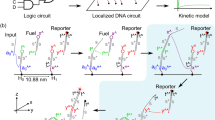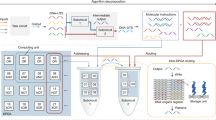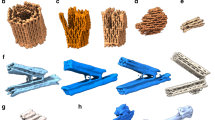Abstract
DNA computing was proposed1 as a means of solving a class of intractable computational problems in which the computing time can grow exponentially with problem size (the ‘NP-complete’ or non-deterministic polynomial time complete problems). The principle of the technique has been demonstrated experimentally for a simple example of the hamiltonian path problem2 (in this case, finding an airline flight path between several cities, such that each city is visited only once3). DNA computational approaches to the solution of other problems have also been investigated4,5,6,7,8,9. One technique10,11,12,13 involves the immobilization and manipulation of combinatorial mixtures of DNA on a support. A set of DNA molecules encoding all candidate solutions to the computational problem of interest is synthesized and attached to the surface. Successive cycles of hybridization operations and exonuclease digestion are used to identify and eliminate those members of the set that are not solutions. Upon completion of all the multi-step cycles, the solution to the computational problem is identified using a polymerase chain reaction to amplify the remaining molecules, which are then hybridized to an addressed array. The advantages of this approach are its scalability and potential to be automated (the use of solid-phase formats simplifies the complex repetitive chemical processes, as has been demonstrated in DNA and protein synthesis14). Here we report the use of this method to solve a NP-complete problem. We consider a small example of the satisfiability problem (SAT)2, in which the values of a set of boolean variables satisfying certain logical constraints are determined.
This is a preview of subscription content, access via your institution
Access options
Subscribe to this journal
Receive 51 print issues and online access
$199.00 per year
only $3.90 per issue
Buy this article
- Purchase on Springer Link
- Instant access to full article PDF
Prices may be subject to local taxes which are calculated during checkout



Similar content being viewed by others
References
Adleman, L. M. Molecular computation of solutions to combinatorial problems. Science 266, 1021–1024 ( 1994).
Garey, M. R. & Johnson, D. S. Computers and Intractability: a Guide to the Theory of NP-completeness (Freeman, New York, 1979).
Adleman, L. M. Computing with DNA. Sci. Am. 279, 54– 61 (1998).
Lipton, R. J. DNA solution of hard computational problems. Science 268, 542–545 (1995).
Guarnieri, F., Fliss, M. & Bancroft, C. Making DNA add. Science 273, 220–223 (1996).
Ogihara, M. Breadth First Search 3SAT Algorithms for DNA Computers (Technical report TR 629, Department of Computer Science, University of Rochester, Rochester, New York, 1996).
Ouyang, Q., Kaplan, P. D., Liu, S. & Libchaber, A. DNA solution of the maximal clique problem. Science 278, 446–449 (1997).
Seeman, N. C. et al. New motifs in DNA nanotechnology. Nanotechnology. 9, 257–273 ( 1998).
Winfree, E., Liu, F. R., Wenzler, L. A. & Seeman, N. C. Design and self-assembly of two-dimensional DNA crystals. Nature 394, 539–544 (1998).
Smith, L. M. et al. A surface-based approach to DNA computation. J. Comput. Biol. 5, 255–267 (1998).
Frutos, A. G. et al. Demonstration of a word design strategy for DNA computing on surfaces. Nucl. Acid. Res. 25, 4748– 4757 (1997).
Frutos, A. G., Smith, L. M. & Corn, R. M. Enzymatic ligation reactions of DNA “words” on surfaces for DNA computing. J. Am. Chem. Soc. 120 , 10277–10282 (1998).
Cai, W. et al. in Proc. 1st Annu. Int. Conf. on Computational Molecular Biology (RECOMB97) 67–74 (Association for Computing Machinery, New York, 1997).
Smith, L. M. Automated synthesis and sequence analysis of biological macromolecules. Anal. Chem. 60, 381A–390A (1988).
Fodor, S. P. A. et al. Light-directed, spatially addressable parallel chemical synthesis. Science 251, 767–773 (1991).
Chee, M. et al. Accessing genetic information with high-density DNA arrays. Science 274, 610–614 ( 1996).
Morimoto, N., Arita, M. & Suyama, A. in Proc. DIMACS: DNA Based Computers (III) (eds Rubin, H. & Wood, D. H.) 83–92 (American Mathematical Society, Providence, 1997).
Yoshida, H. & Suyama, A. in Preliminary Proc. DIMACS: DNA Based Computers (V) 9–20 (American Mathematical Society, Providence, 1999).
Schöning, U. in Proc. 40th Annu. IEEE Conf. of Foundations of Computer Science (FOCS) 410–414 (IEEE Computer Society, Los Alamitos, California, 1999).
Guo, Z., Guilfoyle, R. A., Thiel, A. J., Wang, R. & Smith, L. M. Direct fluorescence analysis of genetic polymorphisms by hybridization with oligonucleotide arrays on glass supports. Nucl. Acid. Res. 22, 5456– 5465 (1994).
Jordan, C. E., Frutos, A. G., Thiel, A. J. & Corn, R. M. Surface plasmon resonance imaging measurements of DNA hybridization adsorption and streptavidin/DNA multilayer formation at chemically modified gold surfaces. Anal. Chem. 69, 4939–4947 (1997).
Bain, C. D. et al. Formation of monolayer films by the spontaneous assembly of organic thiols from solution onto gold. J. Am. Chem. Soc. 111, 321–335 (1989).
Baskaran, N. et al. Uniform amplification of a mixture of deoxyribonucleic acids with varying GC content. Genome Res. 6, 633–638 (1996).
Rees, W. A., Yager, T. D., Korte, J. & von Hippel, P. H. Betaine can eliminate the base pair composition dependence of DNA melting. Biochemistry 32, 137–144 (1993).
Voss, K. O., Pieter Roos, K., Nonay, R. L. & Dovichi, N. J. Combating PCR bias in bisulfate-based cytosine methylation analysis. Betaine-modified cytosine deamination PCR. Anal. Chem. 70, 3818–3823 (1998).
Farrell, R. E. DNA amplification. Immunol. Invest. 26, 3–7 (1997).
Lyamichev, V. et al. Polymorphism identification and quantitative detection of genomic DNA by invasive cleavage of oligonucleotide probes. Nature Biotechnol. 17, 292–296 (1999).
Pippenger, N. Developments in the synthesis of reliable organisms from unreliable components. Proc. Symp. Pure Math. 50, 311– 324 (1990).
Boneh, D., Dunworth, C., Lipton, R. J. & Sgall, J. DNA Based Computers II (eds Landweber, L. F. & Baum, E. B.) 163 –170 (DIMACS Series in Discrete Mathematics and Theoretical Computer Science, Vol. 44, American Mathematical Society, Providence, 1999).
Karp, R. M., Kenyon, C. & Waarts, O. Error-resilient DNA computation. Random Struct. Algor. 15, 450–466 ( 1999).
Gillmor, S. D., Thiel, A. J., Smith, L. M. & Lagally, M. G. Hydrophilic/hydrophobic patterned surfaces as templates for DNA arrays. Langmuir (submitted).
Gallop, M. A., Barrett, R. W., Dower, W. J., Fodor, S. P. A. & Gordon, E. M. Applications of combinatorial technologies to drug discovery. 1. Background and peptide combinatorial libraries. J. Med. Chem. 37, 1233–1251 (1994).
Gordon, E. M., Barrett, R. W., Dower, W. J., Fodor, S. P. A. & Gallop, M. A. Applications of combinatorial technologies to drug discovery. 2. Combinatorial organic synthesis, library screening strategies, and future directions. J. Med. Chem. 37, 1385–1401 (1994).
Acknowledgements
We thank S. Gillmor and J. Brockman for help with the preparation of the photopatterned read-out arrays, and M. Lagally for discussions. This work was supported by the Defense Advanced Research Projects Agency (DARPA) and the National Science Foundation.
Author information
Authors and Affiliations
Corresponding author
Rights and permissions
About this article
Cite this article
Liu, Q., Wang, L., Frutos, A. et al. DNA computing on surfaces. Nature 403, 175–179 (2000). https://doi.org/10.1038/35003155
Received:
Accepted:
Issue Date:
DOI: https://doi.org/10.1038/35003155
This article is cited by
-
DNAQL: a query language for DNA sticker complexes
Natural Computing (2021)
-
Stigmergic electronic gates and networks
Journal of Computational Electronics (2021)
-
Large-scale Ising emulation with four body interaction and all-to-all connections
Communications Physics (2020)
-
Cancer diagnosis with DNA molecular computation
Nature Nanotechnology (2020)
Comments
By submitting a comment you agree to abide by our Terms and Community Guidelines. If you find something abusive or that does not comply with our terms or guidelines please flag it as inappropriate.



